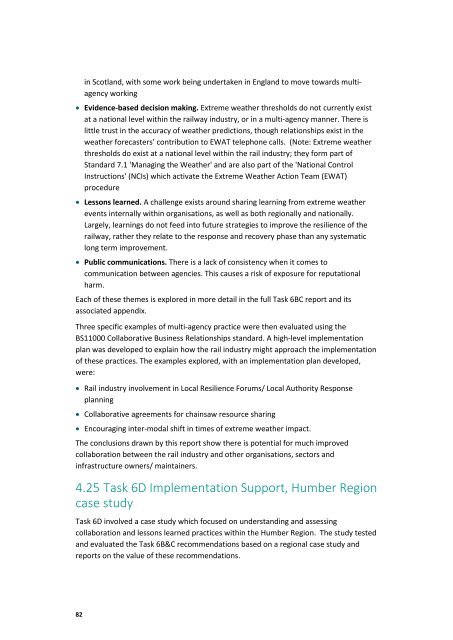Tomorrow's Railway and Climate Change Adaptation Final Report
2016-05-T1009-final-report
2016-05-T1009-final-report
Create successful ePaper yourself
Turn your PDF publications into a flip-book with our unique Google optimized e-Paper software.
in Scotl<strong>and</strong>, with some work being undertaken in Engl<strong>and</strong> to move towards multiagency<br />
working<br />
• Evidence-based decision making. Extreme weather thresholds do not currently exist<br />
at a national level within the railway industry, or in a multi-agency manner. There is<br />
little trust in the accuracy of weather predictions, though relationships exist in the<br />
weather forecasters’ contribution to EWAT telephone calls. (Note: Extreme weather<br />
thresholds do exist at a national level within the rail industry; they form part of<br />
St<strong>and</strong>ard 7.1 'Managing the Weather' <strong>and</strong> are also part of the 'National Control<br />
Instructions' (NCIs) which activate the Extreme Weather Action Team (EWAT)<br />
procedure<br />
• Lessons learned. A challenge exists around sharing learning from extreme weather<br />
events internally within organisations, as well as both regionally <strong>and</strong> nationally.<br />
Largely, learnings do not feed into future strategies to improve the resilience of the<br />
railway, rather they relate to the response <strong>and</strong> recovery phase than any systematic<br />
long term improvement.<br />
• Public communications. There is a lack of consistency when it comes to<br />
communication between agencies. This causes a risk of exposure for reputational<br />
harm.<br />
Each of these themes is explored in more detail in the full Task 6BC report <strong>and</strong> its<br />
associated appendix.<br />
Three specific examples of multi-agency practice were then evaluated using the<br />
BS11000 Collaborative Business Relationships st<strong>and</strong>ard. A high-level implementation<br />
plan was developed to explain how the rail industry might approach the implementation<br />
of these practices. The examples explored, with an implementation plan developed,<br />
were:<br />
• Rail industry involvement in Local Resilience Forums/ Local Authority Response<br />
planning<br />
• Collaborative agreements for chainsaw resource sharing<br />
• Encouraging inter-modal shift in times of extreme weather impact.<br />
The conclusions drawn by this report show there is potential for much improved<br />
collaboration between the rail industry <strong>and</strong> other organisations, sectors <strong>and</strong><br />
infrastructure owners/ maintainers.<br />
4.25 Task 6D Implementation Support, Humber Region<br />
case study<br />
Task 6D involved a case study which focused on underst<strong>and</strong>ing <strong>and</strong> assessing<br />
collaboration <strong>and</strong> lessons learned practices within the Humber Region. The study tested<br />
<strong>and</strong> evaluated the Task 6B&C recommendations based on a regional case study <strong>and</strong><br />
reports on the value of these recommendations.<br />
82


